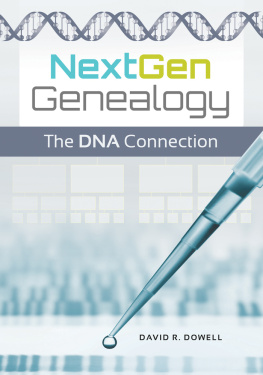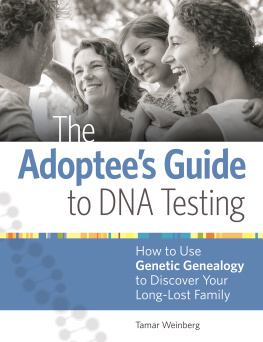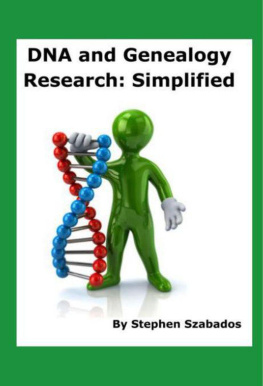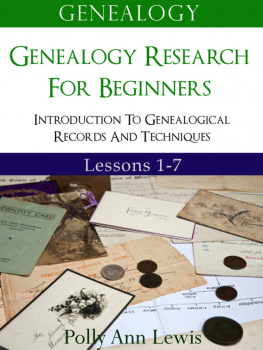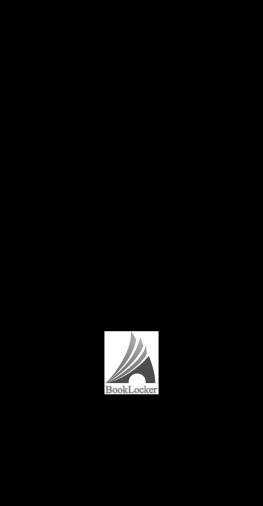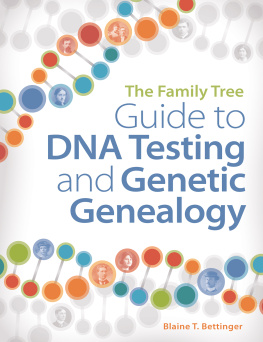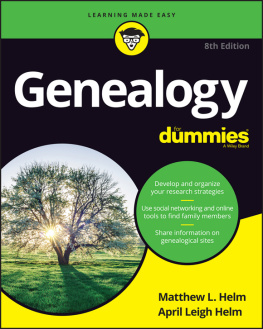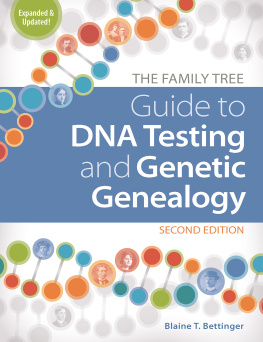NextGen
Genealogy
The DNA Connection
David R. Dowell

Copyright 2015 by David R. Dowell
All rights reserved. No part of this publication may be reproduced, stored in a retrieval system, or transmitted, in any form or by any means, electronic, mechanical, photocopying, recording, or otherwise, except for the inclusion of brief quotations in a review, without prior permission in writing from the publisher.
Library of Congress Cataloging-in-Publication Data
Dowell, David R.
Nextgen genealogy : the DNA connection / David R. Dowell.
pages cm
Includes bibliographical references and index.
ISBN 9781610697279 (pbk. : alk. paper) ISBN 9781610697286 (ebook) 1. Genetic genealogy. 2. DNAAnalysis. I. Title.
CS21.D892015
929.1072dc23 2014026726
ISBN: 9781610697279
EISBN: 9781610697286
191817161512345
This book is also available on the World Wide Web as an eBook.
Visit www.abc-clio.com for details.
Libraries Unlimited
An Imprint of ABC-CLIO, LLC
ABC-CLIO, LLC
130 Cremona Drive, P.O. Box 1911
Santa Barbara, California 93116-1911
This book is printed on acid-free paper 
Manufactured in the United States of America
Contents
Preface
NextGen Genealogy: The DNA Connection is intended to help you appreciate the four separate patterns by which men inherit the four discrete groupings of their DNA. The use of the word men in the previous sentence was deliberate: women inherit through only three of these processes. Being able to differentiate between these patterns of how DNA is passed from parents to child is essential to understanding which test(s) to take for genealogical purposes and how to interpret the results. Used properly, they help us find connections with direct-line ancestors and the cousins who are their descendants.
This book does not come with a money-back guarantee. The family history research of most readers will benefit if you learn to combine the information from within your cells with the information you collect from traditional research. Some of you will be disappointedat least at first. A poor outcome is likely to result from one or more of the following issues:
- Your pedigree chart is not robust enough. Build it. If you are waiting for DNA test results, use the interval to apply documentary research and to extend all of your direct lines back as far as possible but at least eight generations. You may never quite complete this task, but it is a realistic goal. (After decades of research, my own tree still breaks down on a couple of lines after only five generations.) Continue to build your tree as you analyze your DNA test results. You cannot understand where to fit DNA matches into your family unless you have the context provided by a reasonably well-developed family tree.
- Extended family/cousins have not been tested. Recruit them. Lots of people have taken DNA tests, but they still make up a miniscule percentage of the earths inhabitants. Test takers are not evenly distributed throughout all groups. Be proactive in expanding DNA databases to include those who have a high probability of matching you.
- You do not know how to fish the information out. Read on. This book will not provide you with all the techniques you will ever need to know, but it should give you enough to get started.
will provide you with most of the basic genetic concepts and terms you will need to start practicing genetic genealogy. If you do not retain all of its content on first reading, come back later when you have a specific need for a review.
will introduce you to yDNA, mtDNA, atDNA, and xDNAthe four types of human DNA that can be useful to us as genetic genealogists. Each of these chapters will help you understand the unique inheritance pattern of one of these types of DNA and appreciate how you can begin to apply test results in your own family research.
extends your voyage of family history discovery into even earlier eras of your deep ancestry.
raises questions about whether we should test our DNA and how each of us may arrive at different conclusions when ethical issues arise.
discusses what is coming next and gives suggestions for additional learning experiences as you continue your journey into this fast-evolving field.
At the end of this book, you will find recommended reading for further learning, a glossary of terms you may encounter, and a comprehensive index to help you single out specific concepts or terms of interest.
For genealogists, the actual results listed on DNA test reports have little importance. The meaning comes as you make comparisons with others who share (or do not share) part of the information recorded inside your cells. Mastering techniques that allow you to make these assessments will enable you to benefit from adding DNA testing to your genealogical tool kit.
Some readers will be the first of your family to take some of the tests at some of the companies. As a consequence, you may be disappointed with your lack of matches. While this may be the case with results from a Y-chromosome or mitochondrial test, I have yet to meet individuals who did not have matches on their autosomal DNA. Finding the individuals with whom you share DNA and, therefore, a relationship is the easy part. The hard work comes in finding where in your family tree your shared ancestor is perched. This book offers suggestions about how you can choose the test that will give you the best chance of tearing down long-standing genealogical brick walls. It will also help you get started down the sometimes long and tortuous path of making sense of your results and interpreting the matches you get with others.
THE BIRTH OF THIS BOOK
This book was originally the offspring of a genetic match. A few years ago, I discovered that I shared a mitochondrial line with genetic genealogist CeCe Moore. We may never discover who our common female ancestress is, but you will hear more about this match later in the book. After we got acquainted, we decided to write a book to introduce genealogists to the 21st-century tool of genetic genealogy. Subsequently, life and CeCes success as a DNA advisor to television productions intervened and she had to step aside from this project.
At a late stage of the project, Angie Bush came to my rescue and helped me get this manuscript over the finish line. Angie poked holes in my thought process throughout the book. She also helped me identify and fill gaps. She is responsible for strengthening the book, but I alone am responsible for the content and any shortcomings it may have.
While Angie as a molecular genealogist has an extensive background in both genetics and genealogy, I have never taken an academic course in the life sciences. God has decided to punish me for that deficiency by inflicting me with a vast curiosity about how we can and should apply the information discovered inside our bodies by genetic testing to family history research and personal health decisions.
Although this book was written for those of you who have little or no background in genetics, it is assumed that you have a basic knowledge of traditional genealogical principles. If that is not the case, you may want to do some reading in that area, such as Backward Thinking and Other Keys to Successful Genealogical Research (
The primary audience for this book is not the academic community. I have deliberately chosen to communicate in the same breezy style employed in blogs. I have decided to ignore the advice of Mary Jane Frances Smith: The style used to write on a blog, in an e-mail, or in other forums on the Internet is not the style a writer should use in a letter of reference, print magazine, professional journal, or book. If that decision bothers you, you are probably not the intended audience whom I had in mind for this book. There is a time and place for every style. This is a book intended for novices in this exciting new field. It is not a book intended to advance the frontiers of discovery for seasoned experts.
Next page
